
| Target Namespace | http://www.openmicroscopy.org/XMLschemas/CLI/RC1/CLI.xsd |
|---|---|
| Version | RC1 |
| Element and Attribute Namespaces |
|
| Schema Composition |
|
| Documentation | Open Microscopy Environment Command Line Interface XML Schema Author: Josiah Johnston |
| Prefix | Namespace |
|---|---|
| Default namespace | http://www.w3.org/2001/XMLSchema |
| xml | http://www.w3.org/XML/1998/namespace |
| CLI | http://www.openmicroscopy.org/XMLschemas/CLI/RC1/CLI.xsd |
| Name | AutoIterate |
|---|---|
| Type | Locally-defined complex type |
| Nillable | no |
| Abstract | no |
| Documentation | Iterates a dimension over its entire range. Produces outputs. |


| Name | BitsPerPixel |
|---|---|
| Type | Locally-defined complex type |
| Nillable | no |
| Abstract | no |
| Documentation | Specifies an input data location for populating the semantic element |
'This specifies where to find a piece of data by FormalOutputName and SemanticElementName. i.e. To reference Semantic element \'bar\' from Formal Output \'foo\', Location=\"foo.bar\"'
"/>| Name | CommandLine |
|---|---|
| Type | Locally-defined complex type |
| Nillable | no |
| Abstract | no |
| Documentation | This describes the string that will be passed to a command line program via command line parameters. The command line handler will perform basic variable substitution on sub elements of this. Example: when you use the program, you type: /OME/bin/OME_Image_XYZ_stats Path=[path to repository file] Dims=[X],[Y],[Z],[W],[T],[BytesPerPix] XML specification of the command line parameters is: <CommandLine>Path=<RawImageFilePath/> Dims=<sizeX/>,<sizeY/>,<sizeZ/>,<sizeW/>,<sizeT/>,<BPP/></CommandLine> |


| Name | CustomRecord |
|---|---|
| Type | Locally-defined complex type |
| Nillable | no |
| Abstract | no |
| Documentation | Used to construct an arbitrarily formatted record. Not currently supported. email Josiah <siah@nih.gov> if you need this implemented. |


| Name | DelimitedRecord |
|---|---|
| Type | Locally-defined complex type |
| Nillable | no |
| Abstract | no |
| Documentation | Use this to construct a Delimited Record. (i.e. tab delimitted, comma delimitted, etc). At some point this will be expanded to include XYPlanes and RawImageFilePath. |


| Name | End |
|---|---|
| Type | Locally-defined complex type |
| Nillable | no |
| Abstract | no |
| Documentation | Specifies an end point of iteration. Not currently supported. |

'This specifies where to find a piece of data by FormalInputName and SemanticElementName. i.e. To reference Semantic element \'bar\' from Formal Input \'foo\', Location=\"foo.bar\"'
"/>
| Name | ExecutionInstructions |
|---|---|
| Type | Locally-defined complex type |
| Nillable | no |
| Abstract | no |
| Documentation | Tied to DB. Table PROGRAMS Column EXECUTION |

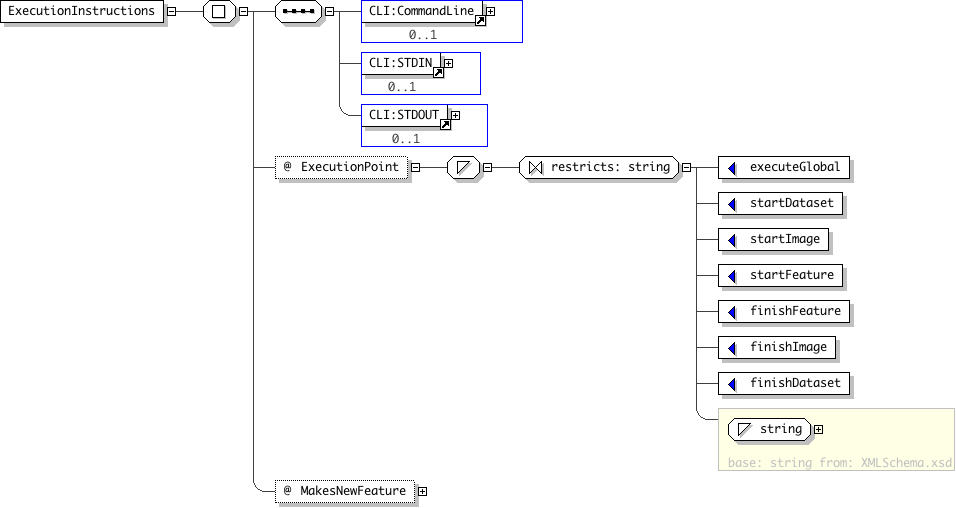
| Name | Index |
|---|---|
| Type | Locally-defined complex type |
| Nillable | no |
| Abstract | no |
| Documentation | This specifies what semantic elements of the attributes should be used to merge them into records. Every formalInput in a record should be included in this. For records with multiple indexes, (Stack Statistics for example has theT and theC), specify two indexes. The records will be sorted based on the index order. This means a stack statistics record that specifies theC as an index before theT will be sorted first on theC, then on theT. |


| Name | Input |
|---|---|
| Type | Locally-defined complex type |
| Nillable | no |
| Abstract | no |
| Documentation | References a particular column in a FormalInput. Used for variable substitution. |

'This specifies where to find a piece of data by FormalInputName and SemanticElementName. i.e. To reference Semantic element \'bar\' from Formal Input \'foo\', Location=\"foo.bar\"'
"
| Name | InputRecord |
|---|---|
| Type | Locally-defined complex type |
| Nillable | no |
| Abstract | no |
| Documentation | Groups a set of inputs into records. |

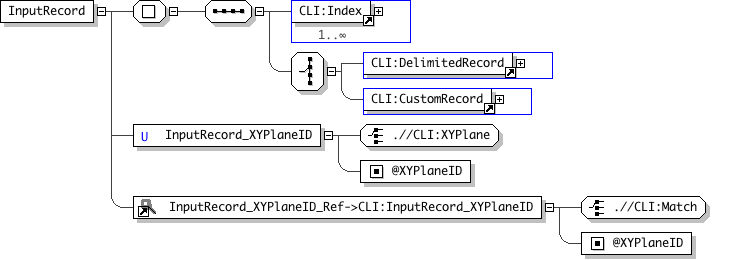
| Name | InputSubString |
|---|---|
| Type | Locally-defined complex type |
| Nillable | no |
| Abstract | no |


| Name | IterateRange |
|---|---|
| Type | Locally-defined complex type |
| Nillable | no |
| Abstract | no |
| Documentation | Iterate this dimension over a range of values. Produces outputs. |


| Name | Match |
|---|---|
| Type | Locally-defined complex type |
| Nillable | no |
| Abstract | no |
| Documentation | Used to reference the index method used by another XYplane. Effectively syncs the planes on certain dimensions. Use with caution. Unsynced dimensions need to be compatible. |


| Name | Output |
|---|---|
| Type | Locally-defined complex type |
| Nillable | no |
| Abstract | no |
| Documentation | References a particular column of a FormalOutput. |


| Name | OutputRecord |
|---|---|
| Type | Locally-defined complex type |
| Nillable | no |
| Abstract | no |
| Documentation | Groups a set of outputs into records. |

'RepeatCount specifies how many times to read a record. If it is not specified, reading will continue until it reaches the end of the output stream. If used in conjuction with TerminateAt, reading will stop after RepeatCount or TerminateAt, whichever comes first.'
"'TerminateAt specifies a regular expression. When a match to this is found, reading will stop. If used in conjuction with RepeatCount, reading will stop after RepeatCount or TerminateAt, whichever comes first.'
"/>
| Name | OutputTo |
|---|---|
| Type | Locally-defined complex type |
| Nillable | no |
| Abstract | no |
| Documentation | Specifies location to write output. One data chunk that the Output element references may be written to one or more places. |

'This specifies where to find a piece of data by FormalOutputName and SemanticElementName. i.e. To reference Semantic element \'bar\' from Formal Output \'foo\', Location=\"foo.bar\"'
"/>
| Name | Parameter |
|---|---|
| Type | Locally-defined complex type |
| Nillable | no |
| Abstract | no |
| Documentation | All Formal Inputs referenced within this scope should have a count of 0 or 1. |


| Name | Path |
|---|---|
| Type | Locally-defined complex type |
| Nillable | no |
| Abstract | no |
| Documentation | Specifies a data location for populating the semantic element |


| Name | PixelOutput |
|---|---|
| Type | Locally-defined complex type |
| Nillable | no |
| Abstract | no |
| Documentation | Allows SemanticTypes Pixels and PixelsPlane to be outputs. The subelements specify locations for the population of data. This data population is useful for a Plane projection algorithm that has the same X and Y dimensions as the Pixels it is operating on. Alternately, these fields may be filled by ouput from STDOUT. The FileSHA1 subelement is automatically calculated for the pixel dump file. |
'Unimplemented. Will subsume all subelements except <Repository> and <Path>. This will reference a formal input. That input be used for copying all possible data that has not been filled by other means.'
">| Name | PixelType |
|---|---|
| Type | Locally-defined complex type |
| Nillable | no |
| Abstract | no |
| Documentation | Specifies an input data location for populating the semantic element |
'This specifies where to find a piece of data by FormalOutputName and SemanticElementName. i.e. To reference Semantic element \'bar\' from Formal Output \'foo\', Location=\"foo.bar\"'
"/>| Name | PixelsInput |
|---|---|
| Type | Locally-defined complex type |
| Nillable | no |
| Abstract | no |
| Documentation | Grants file path to Pixels input. Future plans include dumping pixel file contents as well. |
'This specifies where to find a piece of data by FormalInputName and SemanticElementName. i.e. To reference Semantic element \'bar\' from Formal Input \'foo\', Location=\"foo.bar\"'
"| Name | RawImageFilePath |
|---|---|
| Type | Locally-defined complex type |
| Nillable | no |
| Abstract | no |
| Documentation | Used with variable substitution. This will be substituted with the path and file of the raw pixel dump image file. e.g. /OME/repository/1-tinyTest.ori |


| Name | RawText |
|---|---|
| Type | string |
| Nillable | no |
| Abstract | no |


| Name | Repository |
|---|---|
| Type | Locally-defined complex type |
| Nillable | no |
| Abstract | no |
| Documentation | Specifies an input data location for populating the semantic element |

'This specifies where to find a piece of data by FormalOutputName and SemanticElementName. i.e. To reference Semantic element \'bar\' from Formal Output \'foo\', Location=\"foo.bar\"'
"/>
| Name | STDIN |
|---|---|
| Type | Locally-defined complex type |
| Nillable | no |
| Abstract | no |
| Documentation | This specifies what and how to write to STDIN. Currently this is still in development. I would STRONGLY recommend contacting Josiah <siah@nih.gov> before coding against it. |


| Name | STDOUT |
|---|---|
| Type | Locally-defined complex type |
| Nillable | no |
| Abstract | no |
| Documentation | This specifies what and how to read STDOUT. |


| Name | SizeC |
|---|---|
| Type | Locally-defined complex type |
| Nillable | no |
| Abstract | no |
| Documentation | Specifies an input data location for populating the semantic element |

'This specifies where to find a piece of data by FormalOutputName and SemanticElementName. i.e. To reference Semantic element \'bar\' from Formal Output \'foo\', Location=\"foo.bar\"'
"/>
| Name | SizeT |
|---|---|
| Type | Locally-defined complex type |
| Nillable | no |
| Abstract | no |
| Documentation | Specifies an input data location for populating the semantic element |

'This specifies where to find a piece of data by FormalOutputName and SemanticElementName. i.e. To reference Semantic element \'bar\' from Formal Output \'foo\', Location=\"foo.bar\"'
"/>
| Name | SizeX |
|---|---|
| Type | Locally-defined complex type |
| Nillable | no |
| Abstract | no |
| Documentation | Specifies an input data location for populating the semantic element |

'This specifies where to find a piece of data by FormalOutputName and SemanticElementName. i.e. To reference Semantic element \'bar\' from Formal Output \'foo\', Location=\"foo.bar\"'
"/>
| Name | SizeY |
|---|---|
| Type | Locally-defined complex type |
| Nillable | no |
| Abstract | no |
| Documentation | Specifies an input data location for populating the semantic element |

'This specifies where to find a piece of data by FormalOutputName and SemanticElementName. i.e. To reference Semantic element \'bar\' from Formal Output \'foo\', Location=\"foo.bar\"'
"/>
| Name | SizeZ |
|---|---|
| Type | Locally-defined complex type |
| Nillable | no |
| Abstract | no |
| Documentation | Specifies an input data location for populating the semantic element |

'This specifies where to find a piece of data by FormalOutputName and SemanticElementName. i.e. To reference Semantic element \'bar\' from Formal Output \'foo\', Location=\"foo.bar\"'
"/>
| Name | Start |
|---|---|
| Type | Locally-defined complex type |
| Nillable | no |
| Abstract | no |
| Documentation | Specifies a starting point of iteration. Not currently supported. |

'This specifies where to find a piece of data by FormalInputName and SemanticElementName. i.e. To reference Semantic element \'bar\' from Formal Input \'foo\', Location=\"foo.bar\"'
"/>
| Name | TempFile |
|---|---|
| Type | Locally-defined complex type |
| Nillable | no |
| Abstract | no |
| Documentation | Will be substituted with the full path of the file created. The OutputTo feature is not implemented yet. |

'Should uniquely identify this tempFile. It is used to retrieve the path as a variable.'
"'If specified, the temporary file will be located in the repository. This specifies where to find a repository attribute by FormalInputName and SemanticElementName(s). Following references is valid. e.g. Location=\"PixelInput.Repository\"'
">
| Name | UseValue |
|---|---|
| Type | Locally-defined complex type |
| Nillable | no |
| Abstract | no |
| Documentation | Use an input value. References an input, does not produce an output. |

'This specifies where to find a piece of data by FormalInputName and SemanticElementName. i.e. To reference Semantic element \'bar\' from Formal Input \'foo\', Location=\"foo.bar\"'
"/>
| Name | XYPlane |
|---|---|
| Type | Locally-defined complex type |
| Nillable | no |
| Abstract | no |
| Documentation | Describes an XY plane. Used with variable substitution. This will be substituted with a dynamically generated plane. |
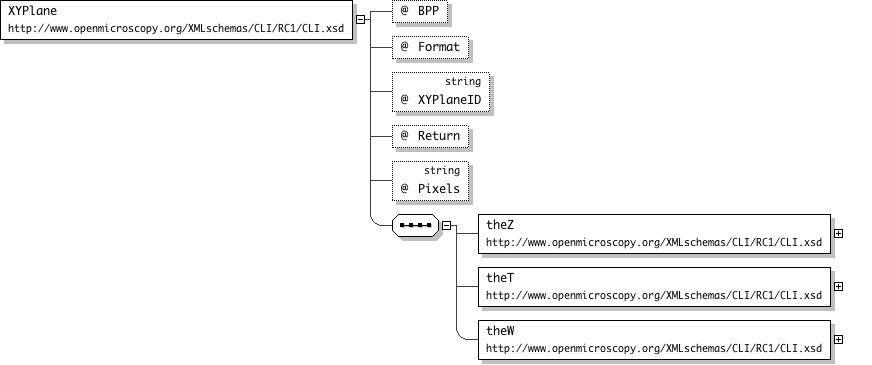
'Specifies bits per pixel (BPP) the module is expecting. If the program can deal with either 8 or 16 bit images, leave this out or specify 16. Both of these result in the BPP of the image being used. That is, if the image is 8 bits, the module will get an 8 bits per pixel. If the image is 16 bits, the module will get 16 bits per pixel. Currently, only native image pixels are supported.'
"'Specifies the expected format of the plane. RAW corrosponds to OME repository format of pixel dump. TIFF corrosponds to TIFF files. Currently only TIFF is supported.'
"'Needed if you need another plane to match indexes. Referenced by the Match element.'
"'Specifies whether to the program needs the FilePath or the FileContents. Currently, only the FilePath is supported.'
"'References a formal input of semantic type \'Pixels\''
">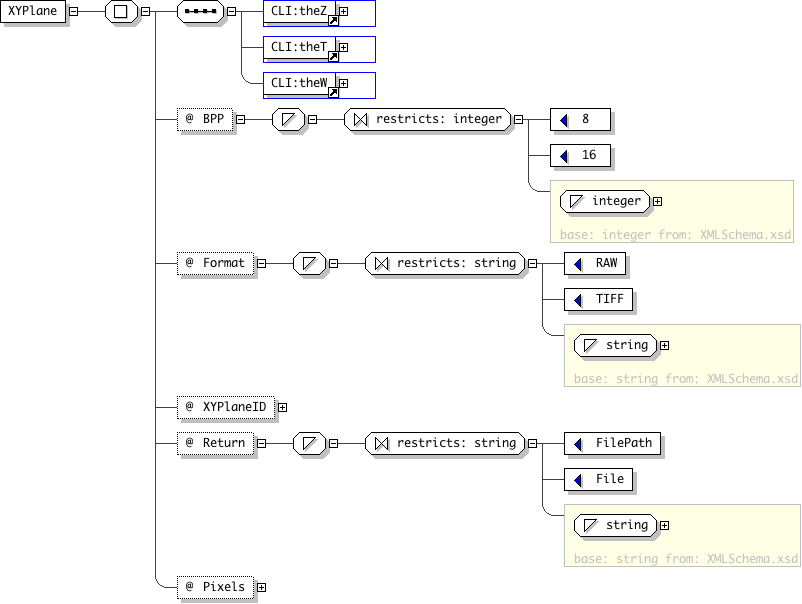
| Name | pat |
|---|---|
| Type | string |
| Nillable | no |
| Abstract | no |
| Documentation | Contains a regular expression. Checked for compilation when the module is imported. |


| Name | theT |
|---|---|
| Type | Locally-defined complex type |
| Nillable | no |
| Abstract | no |
| Documentation | Describes how the time constraints of the XY plane should be produced or acquired. |

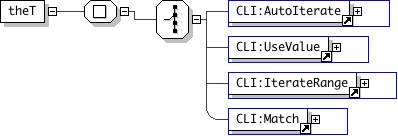
| Name | theW |
|---|---|
| Type | Locally-defined complex type |
| Nillable | no |
| Abstract | no |
| Documentation | Describes how the wavenumber constraints of the XY plane should be produced or acquired. |

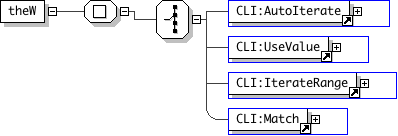
| Name | theZ |
|---|---|
| Type | Locally-defined complex type |
| Nillable | no |
| Abstract | no |
| Documentation | Describes how the Z constraints of the XY plane should be produced or acquired. |

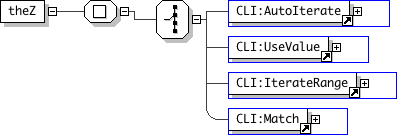
| Name | InputLocation |
|---|
'This specifies where to find a piece of data by FormalInputName and SemanticElementName. i.e. To reference Semantic element \'bar\' from Formal Input \'foo\', Location=\"foo.bar\"'
"
| Name | OutputLocation |
|---|
'This specifies where to find a piece of data by FormalOutputName and SemanticElementName. i.e. To reference Semantic element \'bar\' from Formal Output \'foo\', Location=\"foo.bar\"'
"
| Super-types: | Address < AusAddress (by extension) |
|---|---|
| Sub-types: |
|
| Name | AusAddress |
|---|---|
| Abstract | no |
The XML Instance Representation table above shows the schema component's content as an XML instance.
Abstract (Applies to complex type definitions and element declarations). An abstract element or complex type cannot used to validate an element instance. If there is a reference to an abstract element, only element declarations that can substitute the abstract element can be used to validate the instance. For references to abstract type definitions, only derived types can be used.
All Model Group Child elements can be provided in any order in instances. See: http://www.w3.org/TR/xmlschema-1/#element-all.
Choice Model Group Only one from the list of child elements and model groups can be provided in instances. See: http://www.w3.org/TR/xmlschema-1/#element-choice.
Collapse Whitespace Policy Replace tab, line feed, and carriage return characters with space character (Unicode character 32). Then, collapse contiguous sequences of space characters into single space character, and remove leading and trailing space characters.
Disallowed Substitutions
(Applies to element declarations). If substitution is specified, then substitution group members cannot be used in place of the given element declaration to validate element instances. If derivation methods, e.g. extension, restriction, are specified, then the given element declaration will not validate element instances that have types derived from the element declaration's type using the specified derivation methods. Normally, element instances can override their declaration's type by specifying an xsi:type attribute.
Key Constraint Like Uniqueness Constraint, but additionally requires that the specified value(s) must be provided. See: http://www.w3.org/TR/xmlschema-1/#cIdentity-constraint_Definitions.
Key Reference Constraint Ensures that the specified value(s) must match value(s) from a Key Constraint or Uniqueness Constraint. See: http://www.w3.org/TR/xmlschema-1/#cIdentity-constraint_Definitions.
Model Group Groups together element content, specifying the order in which the element content can occur and the number of times the group of element content may be repeated. See: http://www.w3.org/TR/xmlschema-1/#Model_Groups.
Nillable
(Applies to element declarations). If an element declaration is nillable, instances can use the xsi:nil attribute. The xsi:nil attribute is the boolean attribute, nil, from the http://www.w3.org/2001/XMLSchema-instance namespace. If an element instance has an xsi:nil attribute set to true, it can be left empty, even though its element declaration may have required content.
Notation A notation is used to identify the format of a piece of data. Values of elements and attributes that are of type, NOTATION, must come from the names of declared notations. See: http://www.w3.org/TR/xmlschema-1/#cNotation_Declarations.
Preserve Whitespace Policy Preserve whitespaces exactly as they appear in instances.
Prohibited Derivations (Applies to type definitions). Derivation methods that cannot be used to create sub-types from a given type definition.
Prohibited Substitutions (Applies to complex type definitions). Prevents sub-types that have been derived using the specified derivation methods from validating element instances in place of the given type definition.
Replace Whitespace Policy Replace tab, line feed, and carriage return characters with space character (Unicode character 32).
Sequence Model Group Child elements and model groups must be provided in the specified order in instances. See: http://www.w3.org/TR/xmlschema-1/#element-sequence.
Substitution Group Elements that are members of a substitution group can be used wherever the head element of the substitution group is referenced.
Substitution Group Exclusions (Applies to element declarations). Prohibits element declarations from nominating themselves as being able to substitute a given element declaration, if they have types that are derived from the original element's type using the specified derivation methods.
Target Namespace The target namespace identifies the namespace that components in this schema belongs to. If no target namespace is provided, then the schema components do not belong to any namespace.
Uniqueness Constraint Ensures uniqueness of an element/attribute value, or a combination of values, within a specified scope. See: http://www.w3.org/TR/xmlschema-1/#cIdentity-constraint_Definitions.